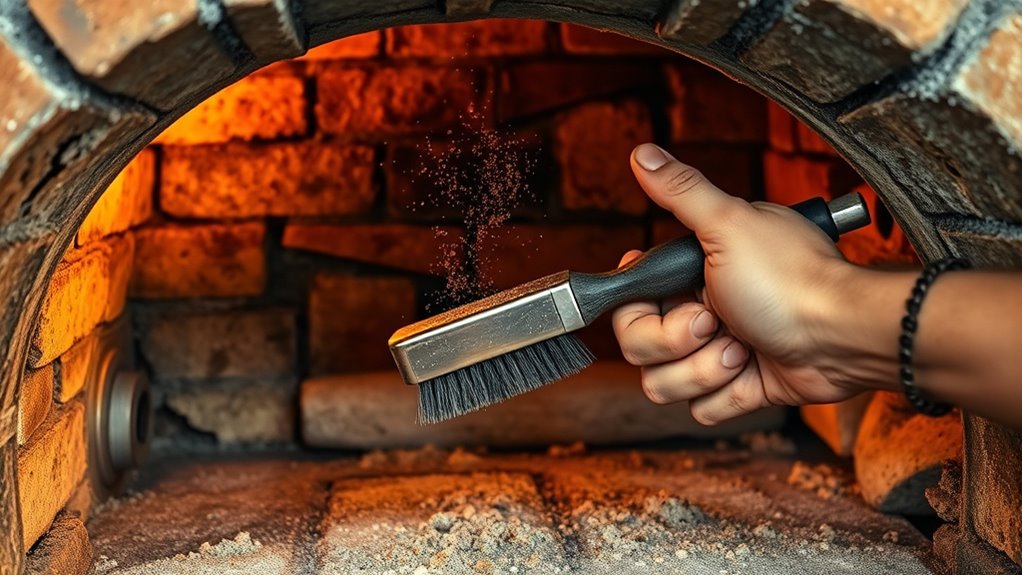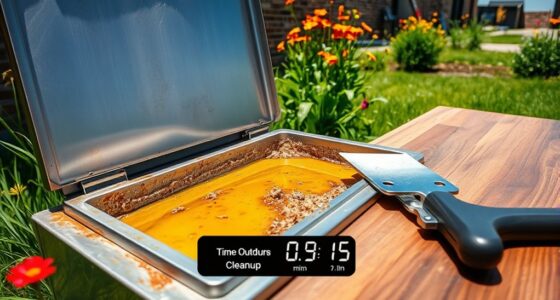To become confident in desooting your wood oven, start by understanding its importance for safe and efficient cooking. Recognize signs like uneven heat or smoky odors that indicate it’s time to clean. Prepare your workspace with gloves, scoops, and brushes, then follow the step-by-step process to remove ashes and soot carefully. Regular maintenance prevents issues and prolongs your oven’s life. Keep going to discover all the tips and tricks for keeping your oven in top shape.
Key Takeaways
- Understand signs of soot buildup and when desooting is necessary to maintain optimal oven performance.
- Prepare workspace with safety gear and essential tools like a wire brush, scraper, and ash vacuum.
- Ensure the oven is completely cool before removing ashes and inspecting the chimney for blockages or creosote.
- Brush interior surfaces, clean the door and glass, and remove ash to prevent airflow restrictions.
- Perform regular maintenance, check seals and vents, and address buildup promptly to ensure safe, efficient operation.
Understanding Why Desooting Is Important

Understanding why desooting is important is essential for maintaining your wood oven’s performance and safety. Ash buildup from previous fires can block airflow, making it harder for your oven to heat efficiently. When airflow is restricted, it takes longer to reach desired temperatures, and you may use more wood than necessary. Additionally, excess ash can cause uneven burning, leading to poor heat distribution. Regular desooting helps clear out ash buildup, ensuring ideal airflow and consistent heat. This process also helps prevent clogged chimneys that can lead to dangerous smoke or fire hazards. Keeping your wood oven clean by removing ash is a simple step that prolongs its lifespan and guarantees safe, reliable operation every time you use it.
Recognizing When Your Oven Needs Desooting
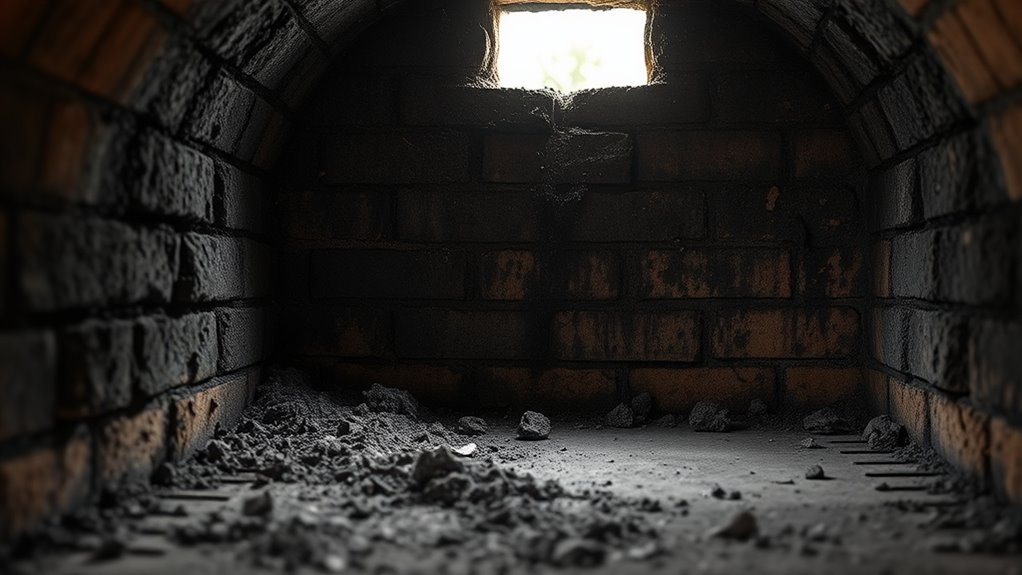
Your wood oven will start to show signs that it’s time for desooting when airflow becomes noticeably restricted. Reduced airflow causes inefficient burns, increasing fire risk and making it harder to control temperatures. You might notice longer cooking times or uneven heating, which indicates soot buildup blocking ventilation. Additionally, a persistent, unpleasant odor may develop, signaling that old soot and creosote are accumulating. If you smell strong, smoky odors when opening the oven, it’s a clear sign that desooting is needed. Regular maintenance not only enhances performance but also minimizes fire hazards. By recognizing these signs early, you can prevent dangerous buildup, improve odor elimination, and keep your wood oven functioning safely and efficiently.
Preparing Your Workspace and Tools
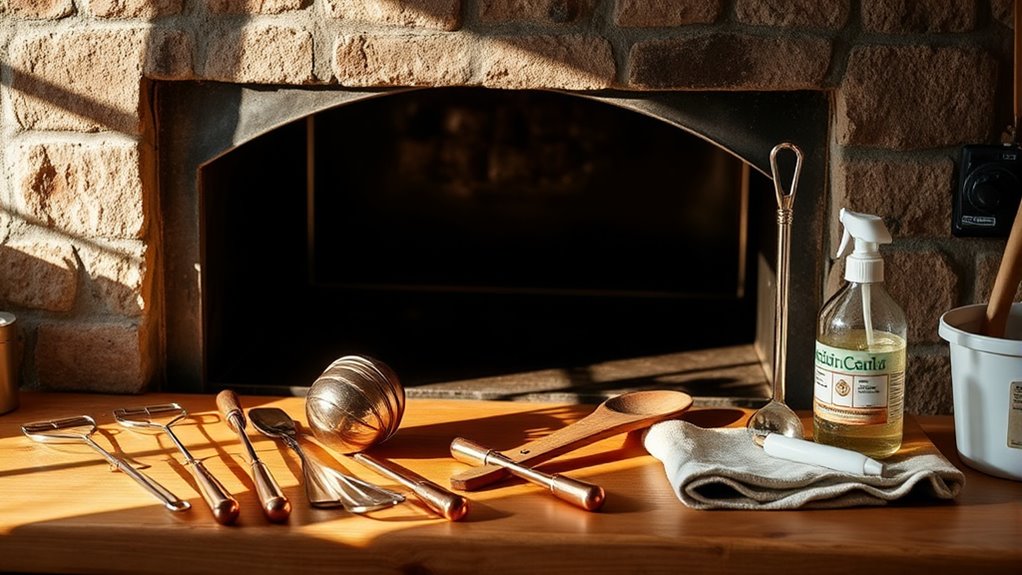
Before you start desooting, it’s important to prepare your workspace and gather the right tools. Clear the area around your wood oven, removing any obstructions to guarantee safety and easy access. Prioritize safety precautions by wearing gloves, goggles, and a dust mask to protect yourself from ash and soot particles. When selecting tools, choose a sturdy wire brush, a scraper, and a vacuum designed for ash removal. Having these tools ready helps you work efficiently and reduces the risk of accidents. Keep a bucket or trash bag nearby for debris. Organizing your workspace beforehand minimizes chaos during the process and assures you follow safety precautions effectively. Proper preparation makes desooting safer, faster, and more effective. Additionally, understanding self watering plant pots can help you maintain a clean and organized environment, especially if you’re using plant-based materials or managing moisture levels around your workspace.
Step-by-Step Guide to Desooting Your Wood Oven
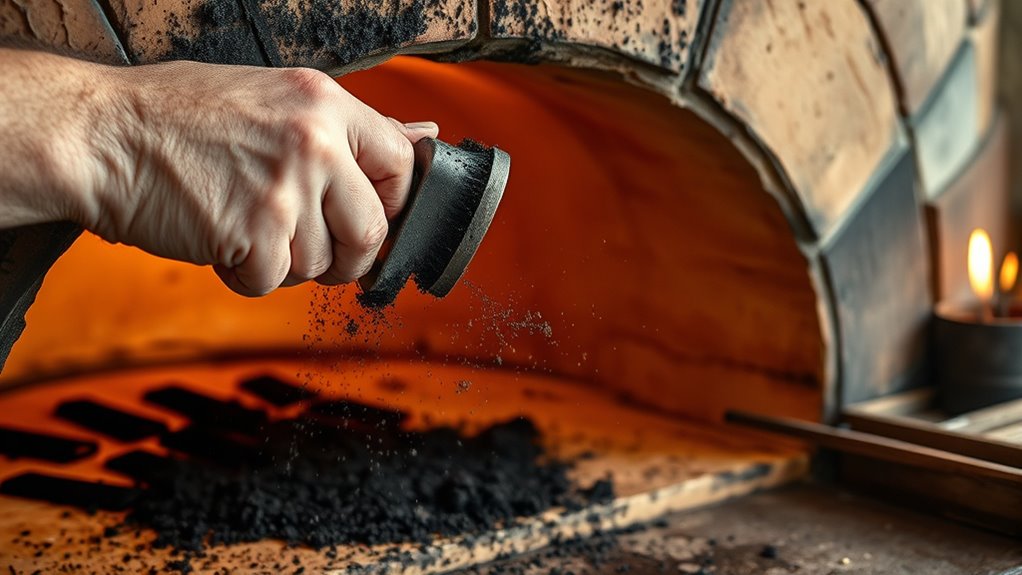
To effectively desoot your wood oven, start by verifying the appliance is completely cool. Next, open the door and remove any remaining ashes or debris. Focus on wood ash removal by collecting ashes in a metal container. Check your chimney for buildup and perform a chimney inspection to prevent blockages. Remove soot from the oven interior using a brush or vacuum designed for high temperatures. Keep these steps in mind:
Always ensure your oven is cool before removing ashes and inspecting for soot buildup.
- Scoop out wood ash and debris
- Use a metal container for ash disposal
- Inspect the chimney for creosote buildup
- Brush away soot from oven walls
- Clean the oven door and glass
- Incorporate advanced data processing speeds to monitor and optimize the desooting process more efficiently
Performing these steps regularly will maintain proper airflow, improve efficiency, and reduce fire hazards. Proper desooting ensures your wood oven stays safe, clean, and ready for use.
Tips for Maintaining a Clean and Efficient Oven
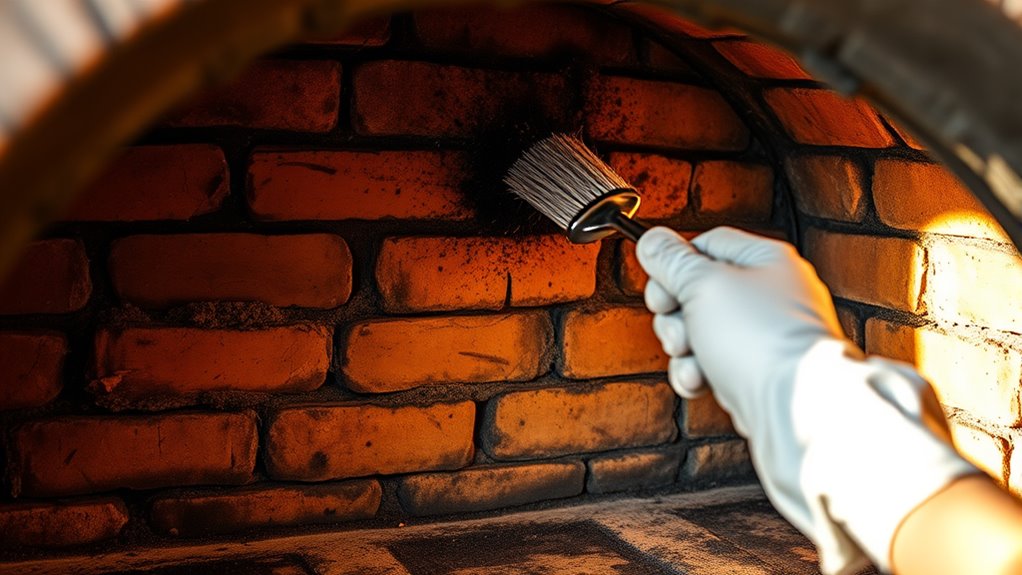
Regularly maintaining your wood oven guarantees it stays clean and operates efficiently. Start by cleaning out ash and soot using appropriate cleaning supplies, which helps improve airflow and heat distribution. Keep the interior surfaces free of debris to prevent fire safety hazards and ensure maximum performance. Use a brush or scraper designed for wood ovens to remove buildup without damaging the oven’s interior. Always inspect the door seals and vents, making sure they’re secure and functioning correctly. Maintaining a clean oven reduces smoke and odors, making cooking safer and more enjoyable. Remember, a well-maintained oven not only extends its lifespan but also guarantees consistent results. Prioritize regular cleaning routines and safety checks to keep your oven in top shape and safe for use. Additionally, adhering to wood stove safety standards and regulations helps prevent accidents and ensures your oven operates within safe parameters.
Troubleshooting Common Desooting Challenges
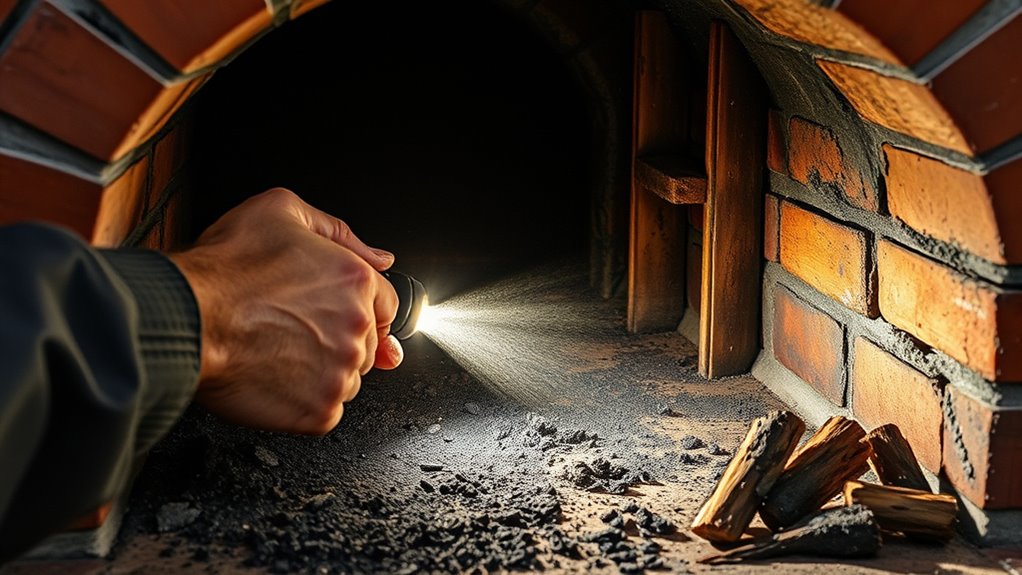
Despite careful maintenance, you might still encounter challenges when desooting your wood oven. Common issues include chimney blockage or excessive ash buildup, which hinder airflow and make cleaning difficult. To troubleshoot, consider these tips:
- Check for chimney blockage and clear any debris or nests
- Remove excessive ash buildup regularly to prevent clogging
- Use a chimney brush to dislodge stubborn soot deposits
- Ensure proper ventilation during desooting
- Inspect the flue for cracks or damage that could trap debris
- Confirm that your ventilation system is functioning correctly to facilitate airflow proper airflow management
Addressing these issues promptly helps maintain ideal airflow and prevents dangerous blockages. If problems persist, it may be time to consult a professional to thoroughly inspect and clean the chimney system. Keeping these challenges in check ensures your wood oven operates safely and efficiently.
Frequently Asked Questions
How Often Should I Schedule Desooting for Optimal Oven Performance?
You should schedule desooting your wood oven every 1 to 2 weeks for peak performance. Regular desooting helps maintain a consistent oven temperature and prevents soot buildup that can affect heat distribution. Use well-seasoned wood to reduce soot and guarantee a cleaner burn. Keep an eye on the oven’s temperature and soot accumulation; if it starts to affect cooking, it’s time to desoot. Frequent maintenance keeps your oven efficient.
Are There Eco-Friendly Methods for Desooting My Wood Oven?
Think of your wood oven as a garden needing tender care. For eco-friendly cleaning, use natural ash removal methods like sweeping out cooled ash with a brush or using eco-safe cleaning solutions. These gentle techniques prevent harsh chemicals from polluting the environment, just like nurturing your garden without harmful pesticides. Embrace natural ash removal to keep your oven clean while protecting the planet and ensuring ideal performance.
Can Desooting Extend the Lifespan of My Wood Oven?
Yes, desooting can extend your wood oven’s lifespan. Regular ash removal prevents buildup that can damage the interior and affect airflow. Chimney cleaning helps avoid creosote buildup, reducing fire risks and improving efficiency. By keeping your oven and chimney clean, you prevent corrosion and wear, ensuring your wood oven stays in great shape longer. Consistent maintenance like ash removal and chimney cleaning is key to longevity.
What Safety Precautions Should I Take During Desooting?
When desooting your wood oven, you should prioritize fire safety and wear protective gear like gloves, goggles, and a dust mask. Make sure the oven is completely cool before starting, and keep a fire extinguisher nearby in case of emergencies. Work in a well-ventilated area to avoid inhaling ash dust, and handle tools carefully to prevent accidents. These precautions help guarantee a safe and effective desooting process.
Is Professional Desooting Necessary or Can I Do It Myself?
You can definitely try DIY techniques for desooting your wood oven, but professional services are recommended for thorough cleaning and safety. If you’re comfortable with basic maintenance and follow safety precautions, you can remove soot buildup yourself. However, for deep cleaning, inspection, and ensuring your oven’s longevity, hiring a professional is best. They have the right tools and expertise to do the job safely and effectively.
Conclusion
Now that you’ve mastered desooting, your wood oven will run smoother than a rollercoaster on a windless day, with fire roaring like a dragon’s breath and heat spreading like wildfire in a forest. No more smoky chaos or stubborn soot battles—just pure, confident mastery of your oven’s soul. Keep up with maintenance, and you’ll turn your cooking space into a legendary culinary fortress, unstoppable and gleaming brighter than a thousand suns!
